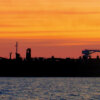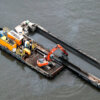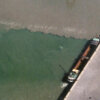Mangroves are trees or shrubs growing in tropical coastal swamps whose strong, tangled roots provide natural protection against waves and storms.
Mangrove habitats are unique
Mangrove habitats are tropical coastal swamps that usually flood during high tides. They typically have numerous tangled roots above ground and form dense thickets. These dense aerial roots bind and build soils and slow down the effects of wind and waves. They help stabilise coastal areas, acting as a natural barrier to storms and tsunamis. This in turn reduces erosion of the coast and protects coastal communities.
Mangroves are sensitive
Mangroves are a type of wetland which has adapted to living in brackish waters. Minor changes, whether natural or anthropogenic, can cause considerable change in the health of the mangroves and the flora and fauna in the mangrove habitat.
The sediments and soils in a mangrove area have a very specific composition. Changes in topography (soil) and hydrology (water) can prevent tidal waters from reaching the mangrove leaving the roots exposed. On the other hand, an excess of sediments carried in by storms or human activities like dredging can smother their roots. Both the lack of water and excess sediments will stop mangrove seedlings from regenerating. This in turn allows the growth of non-mangrove and invasive species.
Coastal protection
Mangroves play a crucial role in coastal protection. Their ability to survive in brackish waters and their dense, aerial root system provide protection from storms, waves and high tides. As has been often reported, broad areas of mangroves have reduced the loss of life and damage caused by hurricanes and tsunamis. They absorb the first brunt of the storm’s impact and dissipate the energy of the waves before they reach the hinterland. As mangrove areas recede along coastlines often by human interventions, they weaken the natural storm defences.
In this context, protecting mangroves and, if necessary, restoring them should be a part of an overall coastal defence plan and dredging projects should be aware of the importance of their preservation.
Dredging near mangroves
Mangroves are extremely productive ecosystems that provide valuable ecological and socio-economic benefits to people living in coastal areas. Damage of mangroves can result in the loss of coastal protection and increased flooding of adjacent lands. Dredging projects must always consider the unique dynamic of nearby mangrove forests.
A dredging project in a sensitive mangrove area requires awareness of the impact that dredging operations can have on mangrove growth if too much sediment enters the shallow waters of a mangrove.
Management of dredging methods is essential. Timing of works and control of turbidity and plumes from equipment as well as the correct disposal of dredged materials is crucial.
Environmental Monitoring and Management Plans
To ensure compliance with environmental standards, when dredging in close proximity to a mangrove area, a comprehensive Environmental Monitoring and Management Plan (EMMP) should be developed. This can incorporate feedback monitoring which will allow work to continue as adjustments can be made in real time.
A first step in managing a dredging project is the Environmental Impact Assessment. The environmental impact assessment can establish a baseline record of the nearby mangrove communities. These parameters of the original conditions must be carefully monitored once dredging begins.
Changes in the surrounding waters and sand can be observed and measured. Turbidity levels and dredging plumes drifting towards mangrove areas are also monitored. Feedback monitoring allows adjustments to be made during the course of the project.
Safe dredging practices
The parameters of the original conditions of the mangrove area must be carefully monitored once dredging begins. Changes in the surrounding waters and sand can be observed and measured. Turbidity levels and dredging plumes drifting towards mangrove areas should always be monitored.
To safely dredge near mangroves some specific dredging technologies may be utilised. Safe dredging practices may include:
- the installation of settlement ponds
- the installation of weir boxes
- the expansion of the run-off systems, creating a longer travel time
- the installation of scum booms and silt screens
- regular maintenance of the above
- real-time monitoring and visual inspections.
These technologies can help mitigate the spread of sediment plumes win areas of strong currents, where material can easily be re-suspended.
Breakwaters, bunds, silt screens, and sometimes removing and replanting mangroves can help insure the survival of this important natural habitat.

























